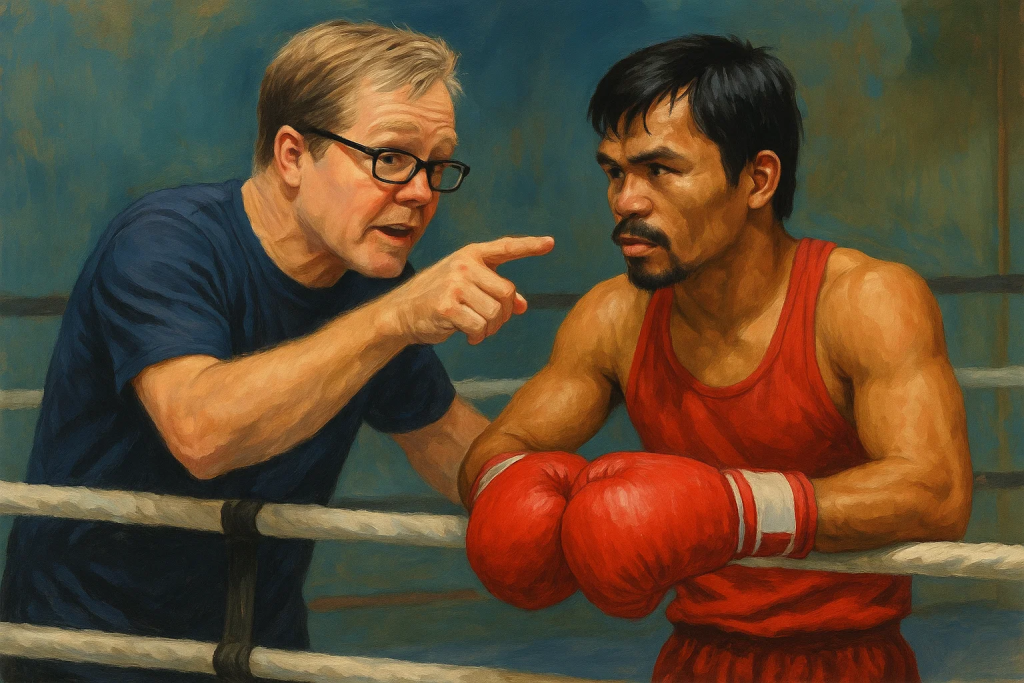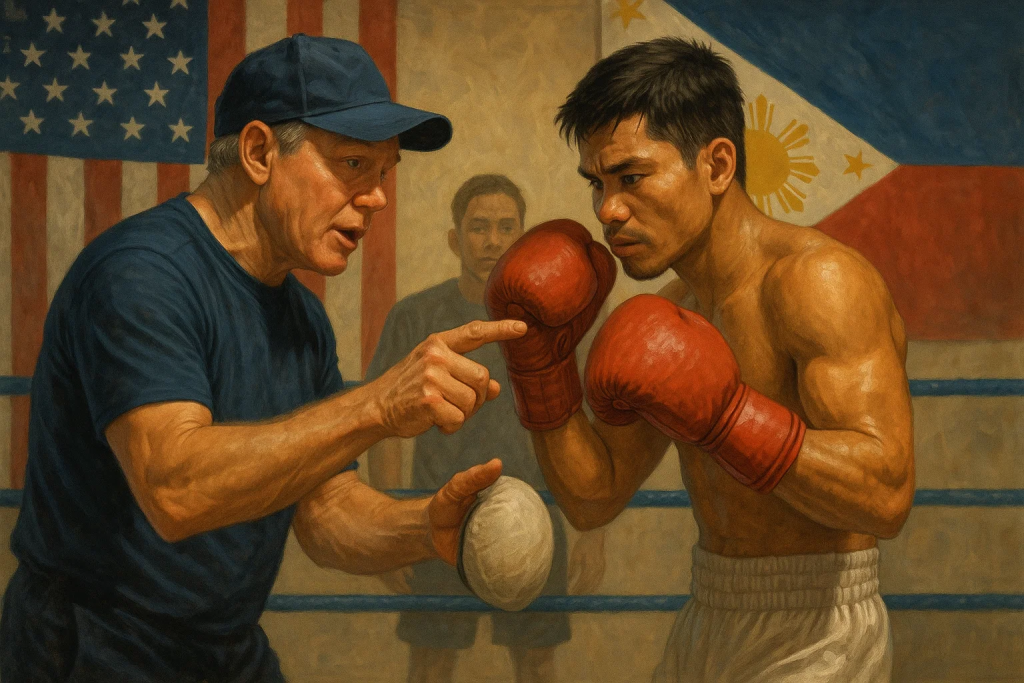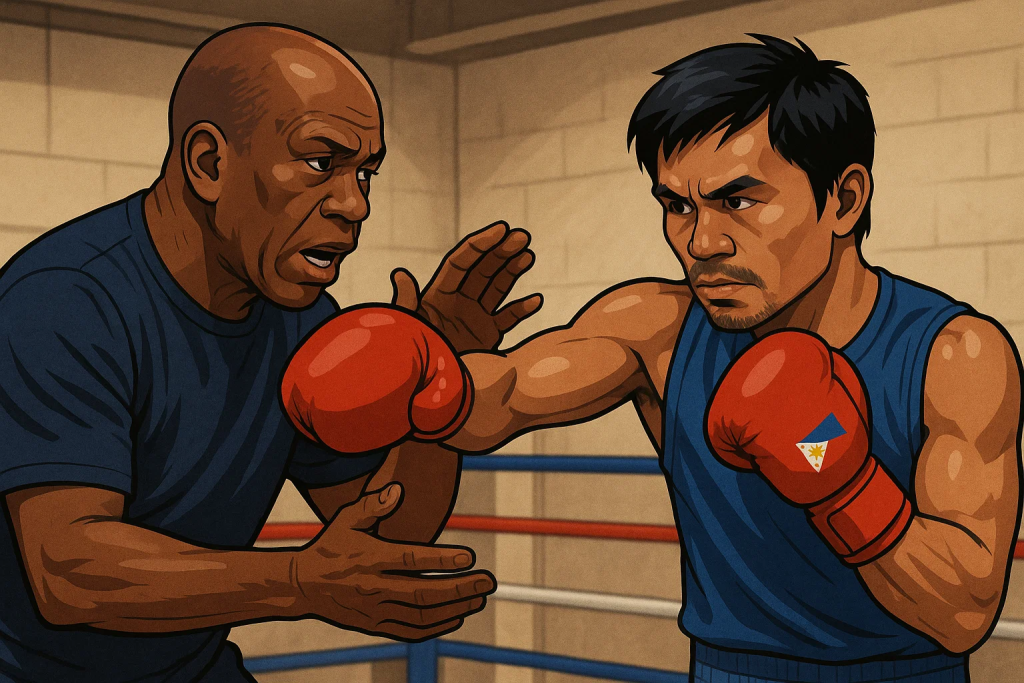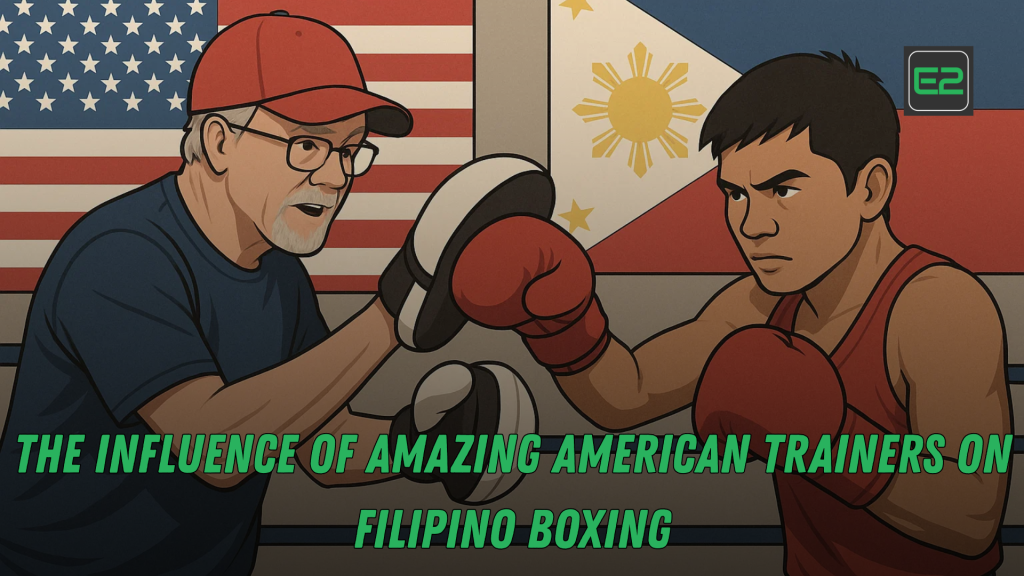Table of Contents
Over the decades, the partnership between Filipino boxers and American trainers has not only transformed individual careers but also elevated the country’s standing in the global boxing arena. In this article, we’ll explore how these trainers have influenced boxing techniques, conditioning programs, career management, and the cultural exchange that has helped shape Filipino fighters into world champions.
Filipino boxing has long been celebrated for its grit, heart, and relentless fighting spirit. From Manny Pacquiao’s meteoric rise to the international spotlight to the new wave of promising fighters, the Philippines has consistently produced world-class talent. But behind many of these success stories is a powerful, often overlooked influence—the presence and mentorship of American boxing trainers.

A Historical Overview of American Influence in Philippine Boxing
Early Exchanges
The Philippines’ boxing scene started gaining traction in the early 20th century, during the American colonial period. The U.S. military presence introduced Western-style boxing to Filipinos, replacing traditional martial arts-based fighting exhibitions with regulated bouts.
By the mid-1900s, the country began producing champions like Gabriel “Flash” Elorde, who trained with American coaches to hone his skills in defense and counterpunching—a style less common in purely local training programs.
The Pacquiao-Freddie Roach Era
No discussion about American trainers in Filipino boxing would be complete without mentioning Freddie Roach, the Hall of Fame coach who shaped Manny Pacquiao into an eight-division world champion. Their partnership became a blueprint for how Filipino fighters could benefit from American training philosophies: blending relentless offense with disciplined defensive strategy.
Technical Advancements Brought by American Trainers
1. Scientific Training Methods
American trainers often bring a data-driven approach to boxing:
- Video analysis to correct flaws in form.
- Specialized strength and conditioning programs.
- Recovery and nutrition planning tailored for fighters.
This contrasts with the traditional “gym war” mentality, where boxers focus heavily on sparring without as much emphasis on recovery or injury prevention.

2. Tactical Evolution
American coaches tend to refine:
- Ring IQ – Teaching fighters how to read opponents and adapt mid-fight.
- Footwork and Angles – Moving in ways that minimize damage while creating offensive opportunities.
- Combination Punching – Developing fluid multi-punch sequences instead of relying on single power shots.
3. Defensive Mastery
Filipino fighters are known for their aggression, but American trainers often balance that with defensive tools like:
- Shoulder rolls
- Slip-and-counter techniques
- Lateral movement to avoid unnecessary punishment
Cultural and Psychological Impact
Building Confidence on the World Stage
Training under American coaches exposes Filipino fighters to a higher level of competition early in their careers. It prepares them mentally to fight in big arenas, in front of foreign crowds, and under intense media scrutiny.
Bridging Cultural Gaps
Many American trainers have adapted to Filipino customs, learning local languages and embracing hospitality traditions. This bond fosters trust, which is crucial for a fighter-coach relationship.
Case Studies: Filipino Fighters Molded by American Trainers
Manny Pacquiao & Freddie Roach
Perhaps the most iconic example, Pacquiao’s career skyrocketed after teaming up with Roach at the Wild Card Gym in Los Angeles. Under Roach, Pacquiao improved his right hand, developed better defensive movement, and became a multi-dimensional threat.
Nonito Donaire & Robert Garcia
Nonito “The Filipino Flash” Donaire thrived under Garcia’s guidance, refining his counterpunching and timing—skills that extended his career and allowed him to compete at an elite level well into his late 30s.
Jerwin Ancajas & Joven Jimenez (with American Training Exposure)
While Ancajas is trained by a Filipino coach, he’s spent significant time in U.S. training camps, gaining exposure to American sports science and sparring partners, which contributed to his long IBF super flyweight title reign.
The Business Side: Career Management and Global Exposure
American trainers often have connections to promoters, matchmakers, and sponsors. This network opens doors for Filipino fighters to:
- Secure lucrative fight deals.
- Gain exposure in top U.S. boxing events.
- Access global media coverage.
In many cases, having an American trainer is a ticket to Las Vegas and Madison Square Garden, where career-defining bouts take place.

Challenges and Criticisms
Language and Communication Barriers
Not all trainer-fighter pairings work smoothly. Miscommunication can lead to confusion during fight strategy planning.
Overemphasis on U.S.-Style Boxing
Some critics argue that overly adapting to American styles can dilute the unique Filipino fighting spirit—a blend of courage, adaptability, and unpredictability.
Cost of Training Abroad
Training in the U.S. can be expensive, and not all Filipino boxers have the resources or sponsorship to afford long overseas camps.
The Future: Evolving Partnerships
With technology and remote training, more American trainers are now conducting virtual coaching sessions for Filipino fighters. This hybrid approach combines the best of both worlds:
- Local gym access in the Philippines.
- Technical guidance from American experts.
Emerging prospects like Eumir Marcial in boxing and John Riel Casimero (who has worked with U.S. trainers) signal that the partnership between Filipino talent and American expertise will continue to flourish.
How American Trainers Are Shaping the Next Generation
The influence is not limited to elite professionals—grassroots boxing programs in the Philippines are starting to adopt American training systems, teaching young fighters:
- Strength conditioning fundamentals.
- Nutrition and weight management.
- Psychological preparation for competition.
This early exposure helps them transition more smoothly to international competition.
A Winning Combination
Impact on Training & Style
- Technical Enhancements – American trainers introduce sophisticated footwork, defensive maneuvers, and ring IQ improvements.
- Sports Science Integration – Use of modern conditioning, nutrition planning, and recovery programs to extend fighters’ careers.
- Strategic Evolution – Shifting from a purely aggressive style to a balanced offense–defense approach that works better in international matches.
Global Opportunities
- American trainers connect Filipino fighters to prominent promotions, global tournaments, and high-profile fight cards in Las Vegas, New York, and Dubai.
- Enhanced visibility helps secure endorsements and media exposure.
The synergy between American trainers and Filipino boxers has created some of the most remarkable success stories in sports. While challenges exist, the technical improvements, career opportunities, and global exposure outweigh the drawbacks. As the sport evolves, this partnership will remain a cornerstone of Philippine boxing’s global success.
The article explains how American trainers have significantly shaped Filipino boxing by improving techniques, introducing sports science, and opening doors to global opportunities.
It traces the influence from the early 20th century, highlighting key partnerships like Manny Pacquiao and Freddie Roach, and Nonito Donaire with Robert Garcia. These trainers bring structured conditioning, advanced tactics, and defensive skills to balance the naturally aggressive Filipino style.
Beyond physical training, American coaches boost fighters’ confidence on the world stage and help connect them to major promotions, leading to bouts in Las Vegas and other top venues. While challenges like cultural differences, costs, and possible overreliance on U.S. styles exist, the partnership continues to evolve with hybrid local-and-remote training.
The conclusion stresses that this synergy has created champions and will remain vital to the future of Philippine boxing, encouraging aspiring boxers to seek the best mentorship available.
American trainers have transformed Filipino boxing—producing champions, refining styles, and connecting fighters to the world stage. The article encourages aspiring boxers to seek top-tier mentorship, whether from local or international sources, to continue the legacy.
Share us your thoughts!
Are you an aspiring boxer or a coach looking to level up your skills? Whether you train locally or abroad, the key is learning from the best. Follow international boxing trends, seek mentorship from experienced trainers, and always strive to adapt and improve. The next Filipino world champion could be you.
FAQs (Frequently Asked Questions)
1. Why do many Filipino boxers train under American coaches?
Because American trainers bring advanced techniques, sports science knowledge, and strong connections in the global boxing industry.
2. Who is the most famous American trainer in Philippine boxing history?
Freddie Roach, best known for training Manny Pacquiao.
3. Does training in the U.S. guarantee success for Filipino boxers?
Not necessarily—success still depends on the fighter’s dedication, adaptability, and natural talent.
4. How do American trainers adapt to Filipino culture?
Many learn basic Tagalog or Visayan phrases, respect local customs, and build personal relationships beyond the gym.
5. Can Filipino boxers succeed without American trainers?
Yes, but having an American trainer often accelerates skill development and increases international fight opportunities.
